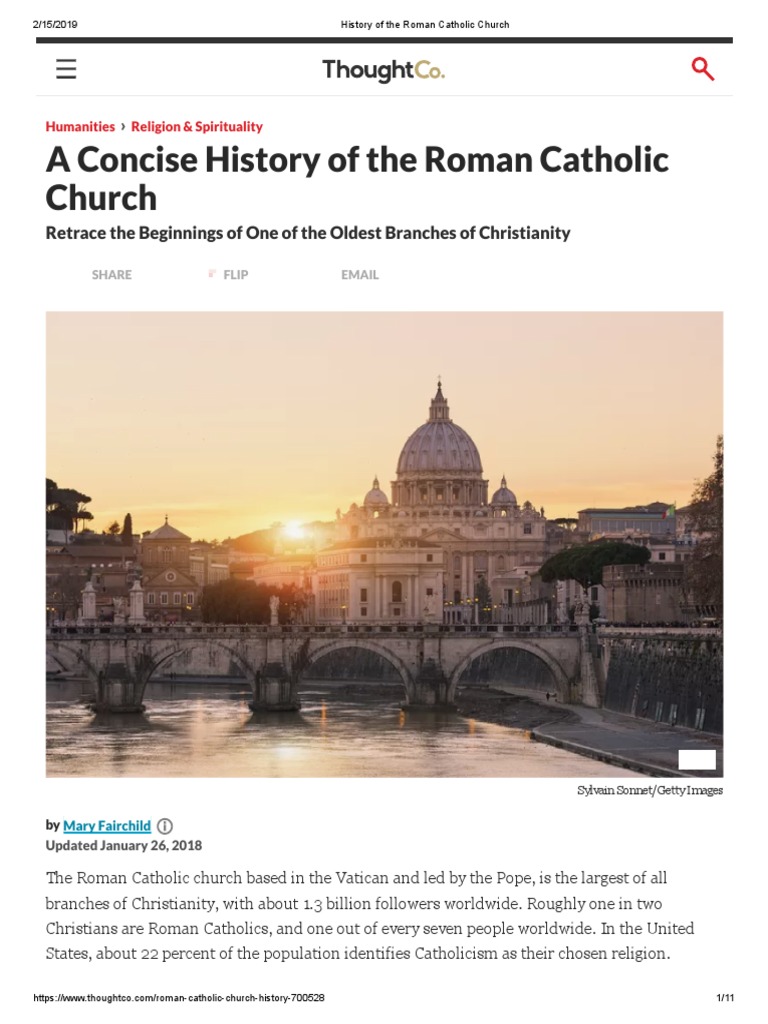The origins of the Roman Catholic Church are intricately woven into the fabric of Christian history. Understanding where the Church came from requires a multifaceted approach, delving into biblical teachings, historical context, and the evolution of church traditions. It is an inquiry that beckons thoughtful reflection on the significance of Apostolic Tradition within the life of the Church.
At the heart of this exploration lies a question: What if the very foundation of the Church is more than just a matter of historical chronology? What if it encapsulates the living legacy of faith passed down through generations? The Roman Catholic Church, as the oldest institution within Christendom, claims a unique lineage that can be traced back to the Apostles. However, this assertion invites both fascination and skepticism among believers and historians alike.
The genesis of the Roman Catholic Church begins with the life and ministry of Jesus Christ. The Gospels recount how Jesus chose twelve disciples, referred to as the Apostles, to carry forth his teachings. Initially, this band of followers spread the news of salvation in an oral tradition, rooted in the belief that Christ was the Messiah. It is through these men—the first bishops and leaders of the early Christian community—that the groundwork for the Church was laid.
The term “Catholic” itself, derived from the Greek word “katholikos” meaning “universal,” signifies a Church that transcends local boundaries to convey a universal message of Christ’s love. After Christ’s ascension, the Apostles began to preach throughout the Mediterranean, establishing communities and bestowing teachings that would shape future generations. This missionary zeal was not merely personal devotion; it was a mandate to perpetuate the faith of Christ. Thus, the seeds of the Church were sown across diverse cultures.
To comprehend Apostolic Tradition, one must recognize its distinctiveness from the written Scriptures. The latter comprises the texts of the Old and New Testaments, while Apostolic Tradition encompasses the oral teachings, practices, and liturgical rituals that were handed down among the early Christians. This dual foundation created a holistic Church framework, crucial for the faithful’s understanding of God’s revelation.
As the early Christian communities thrived, the role of the bishops became increasingly significant. They were seen as successors to the Apostles, tasked with preserving the teachings of Jesus and safeguarding the integrity of the faith. This line of succession is vital; it lends an authoritative dimension to the Church’s doctrines. The belief is that, through Apostolic Succession, the Church maintains an uninterrupted link to the teachings of Christ himself. This idea of continuity serves as a bulwark against heresies and misunderstandings that may arise over time.
In the Apostolic Age, this gradual emergence of the Church witnessed outlined doctrines and structures. The Nicean Creed, established in 325 AD during the First Council of Nicaea, embodies a collective understanding of Christian faith, solidifying key aspects such as the divinity of Christ and the Holy Trinity. This moment marks a pivotal point in the evolution of Christian doctrine and community, as bishops convened to define key beliefs central to the faith. It sets a precedent for the development of patriarchates and future councils that would evoke both conflict and resolution within Christian doctrine.
As centuries unfolded, the Church faced myriad challenges—including political strife, theological dissent, and cultural shifts—that tested the resiliency of its foundational tenets. The Great Schism of 1054 marked a profound turning point in Christian history, leading to the formal division between the Roman Catholic Church and the Eastern Orthodox Church. This schism underscored the complex interplay between faith and politics and posed significant questions about authority and tradition in the Christian community.
The emergence of Protestantism in the 16th century further complicated this narrative, as reformers such as Martin Luther sought to challenge certain practices and teachings of the Roman Catholic Church. The ensuing Counter-Reformation resulted in a reaffirmation of the Church’s commitment to Apostolic Tradition. In many ways, this period solidified a distinction within the Catholic Church between essential doctrines and cultural shifts, emphasizing the importance of collective memory and continuity in faith.
In contemporary discourse, the notion of Apostolic Tradition remains a cornerstone of Catholic belief, particularly emphasized in the teachings of the Second Vatican Council. The Church, aware of the modern challenges it faces, continues to advocate for the relevance of tradition in a rapidly changing world. Yet, while tradition is regarded as sacred, there exists a dynamic tension between tradition and the necessity for adaptation within the context of modernity.
This complexity also invites readers to ponder: How should the Church navigate the fine line between preserving tradition and engaging with contemporary culture? What does it mean to remain authentic to the faith while embracing the realities of modern life? These questions highlight an ongoing dialogue within the Church about its role, mission, and approach to evangelization.
In summation, the Roman Catholic Church’s origins are not merely a historical account but rather an ongoing narrative encompassing faith, tradition, and community. The interplay of Apostolic Tradition and Scripture has shaped the Church into a resilient entity, rooted in its past yet responsive to the present. Each generation of believers is beckoned to partake in this legacy, creating their contribution to an ever-evolving tapestry of faith. Thus, the question lingers: How will the next chapter in the story of the Roman Catholic Church be written?



